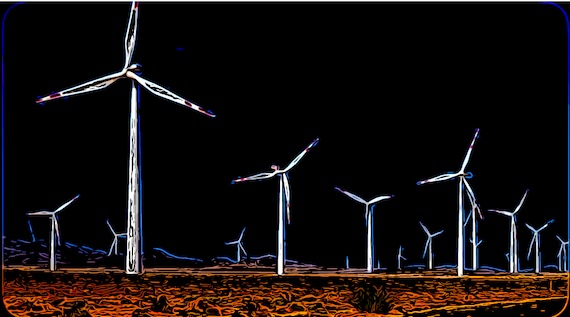Ann Arbor (Informed Comment) – The only place I’ve ever heard of along the Egyptian mainland’s Red Sea coast is the resort city of Hurghada . I never got there, being a workaholic. I was mainly a Cairo guy during my nearly 4 years off and on in that country.
So I didn’t know anything about Ras Gareb, about a hundred miles north of Hurghada on the Red Sea, and more specifically on the latter’s Gulf of El Zayt. The same Gustave Eiffel who designed the Eiffel Tower in Paris was hired by Ottoman viceroy Khedive Ismail in 1871 to design a lighthouse at Ras Gareb. Ras Gareb was only founded as a town in 1932, because there is an oil field in the area. It is a small town, probably with a population of less than 50,000. So this part of Egypt is already entangled in modernism — the lighthouse was for Red Sea steamship traffic.
Now, it is the site of the largest wind farm on the African continent, and a complex of two wind farms there generates nearly a gigawatt (914 megawatts) of power, enough to provide electricity to 1.1 million Egyptian households!
Back in the 1950s, when Egypt wanted to build an Aswan Dam, it initially went to the US because of its wealth and expertise. When Washington tried to dominate Egypt and cut it off from its Eastern European markets, Cairo rebelled and turned to the Soviet Union to finish the dam.
But now the United States and Russia aren’t in the picture for this enormous infrastructure project. Japan and France are.
Toyota Tsusho built Gulf of Suez Wind Farm I near Ras Gareb in 2019, with a power generation capacity of 262.5 megawatts.
The company then partnered with its partially owned subsidiary, Japan’s Eurus Energy, which is also partly owned by TEPCO; with France’s Engie S.A., and with Egypt’s Orascom Construction PLC to create a truly vast wind farm with really huge turbines, the Gulf of Suez Wind Farm II.
ESI Africa reports that the Gulf of Suez Wind Farm II is fully operational, having added 150 megawatts in capacity in March. It is therefore putting out 654 megawatts.
The new wind farm cost $790 million, having begun construction in 2023. The financing was handled by Japanese banks, a French one, and by the European Bank for Reconstruction and Development. A Japanese concern covered the insurance. The speed with which Toyota Tsusho and its partners erected this massive project is just incredible, and it underlines why wind and solar are the future. The installation has 104 turbines. Twenty of them are so gigantic that they each put out 7.5 megawatts. The other 84 aren’t chopped liver, either, each with a 6 megawatt nameplate capacity.
Gulf of Suez Wind Farm II is now fully connected to the Egyptian grid. Along with Wind Farm I at the same location it will power as many households as there are in the entire state of Kansas. It is a 25-year contract and Japan will repatriate profits from it.
Trump’s United States will not. Of wind power, Trump said, “We’re not going to be having that.”
Egypt wants 42% of its electricity to come from renewable sources by 2030, and this new large Japanese-built wind complex will help it meet that (overly modest) goal.

“Suez Wind,” Digital, Dream / Dreamland v3 / Clip2Comic, 2025
Some $4 billion in international and some Egyptian financing is currently being invested in wind and solar projects in Egypt, aiming to add 4 gigawatts of clean energy to the grid, according to the Egyptian ministry of energy. This includes a big solar farm at Abydos and other gigantic projects.
Unlike current US Environmental Protection Agency head Lee Zeldin, who is attempting to destroy the American environment, Egypt’s Minister of Environment, Yasmine Fouad, is a genuine environmentalist. Egypt’s President Abdelfattah al-Sisi may be a repressive dictator and the leader of a fossil gas state, but he, unlike Trump and his cabinet and his party, has no doubt about the deleterious impact of climate change on Egypt. He has complained that Africa contributed least to carbon dioxide emissions but will likely be most devastatingly affected by them.


 © 2025 All Rights Reserved
© 2025 All Rights Reserved